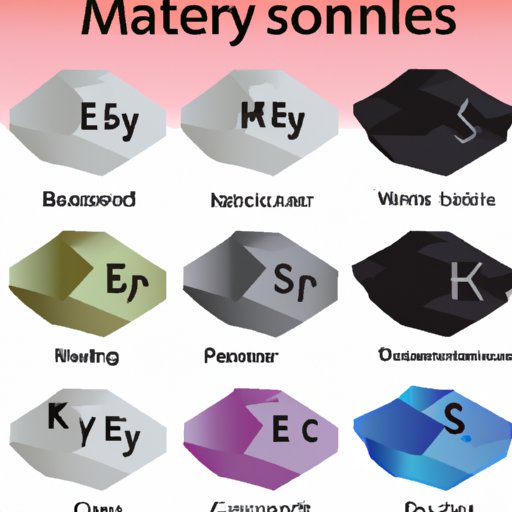Introduction
Minerals are naturally occurring substances composed of atoms that have a specific arrangement and form a crystalline structure. They are found in rocks, soil, water, and other geological formations. Minerals have unique physical and chemical properties that are determined by factors such as their chemical composition, physical properties, formation environment, and impurities.
Analyzing the Chemical Composition of Minerals
The chemical makeup of a mineral is one of the most important factors that determine its properties. Minerals are typically composed of a combination of elements, including carbon, hydrogen, oxygen, nitrogen, sulfur, iron, magnesium, calcium, potassium, sodium, and many others. Each of these elements contributes to the overall characteristics of the mineral.
In addition to the elemental makeup of minerals, the chemical bonding between atoms also affects the properties of a mineral. For example, covalent bonds, which involve the sharing of electrons between two atoms, tend to produce stronger minerals than ionic bonds, where electrons are transferred from one atom to another.

Examining the Physical Properties of Minerals
The physical properties of minerals can provide clues about their chemical composition and formation environment. Color is one of the most obvious physical properties of minerals and can be used to identify them in the field. Refractive index, or the amount of light that a mineral reflects, is another useful property for mineral identification.
Hardness is another important physical property of minerals that helps to distinguish between different types. The Mohs scale of hardness is used to measure the relative hardness of minerals, with talc being the softest at 1 and diamond being the hardest at 10. Cleavage and fracture are two different ways that minerals break apart when struck, and these patterns can also help to identify them.
The shape of a mineral’s crystal can also provide information about its properties. Crystals can be cubic, hexagonal, or any other shape, and the type of crystal can indicate the conditions under which the mineral formed.

Exploring the Geologic Origin of Minerals
Minerals form in different types of rocks, depending on the environment in which they form. Igneous rocks are formed when molten rock cools and solidifies, while metamorphic rocks form when existing rocks are exposed to extreme temperatures and pressures. Sedimentary rocks form when layers of sediment are compressed and cemented together.
The type of rock in which a mineral forms can provide clues about its properties. For example, minerals that form in igneous rocks will typically have higher melting points than those that form in metamorphic rocks.
Investigating the Role of Temperature and Pressure in Mineral Formation
Temperature and pressure play a major role in the formation of minerals. Heat and pressure can cause molecules to rearrange themselves into new crystalline structures, and this process can produce a wide variety of different minerals. Magma, or molten rock, can also contain dissolved gases that can affect the properties of the minerals that form from it.

Understanding the Effect of Impurities on Mineral Properties
Impurities can also affect the properties of minerals. Substances like iron and sulfur can change the color, hardness, and other characteristics of a mineral. Impurities can also alter the chemical bonding between atoms, causing minerals to form with different structures.
Impurities can also affect the stability of a mineral. Some impurities can cause a mineral to be more prone to weathering and decomposition, while others may make it more resistant to environmental changes.
Conclusion
The properties of minerals are determined by several factors, including their chemical composition, physical properties, geologic origin, temperature and pressure, and impurities. Understanding these factors can help to identify unknown minerals and gain insight into the conditions under which they formed.
By analyzing the chemical makeup of minerals, examining their physical properties, exploring the geologic environment in which they form, investigating the role of temperature and pressure, and understanding the effects of impurities, we can gain a better understanding of what determines the properties of a mineral.
(Note: Is this article not meeting your expectations? Do you have knowledge or insights to share? Unlock new opportunities and expand your reach by joining our authors team. Click Registration to join us and share your expertise with our readers.)
